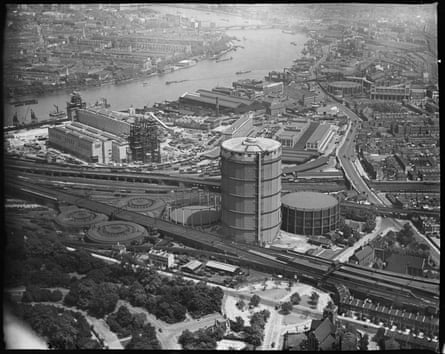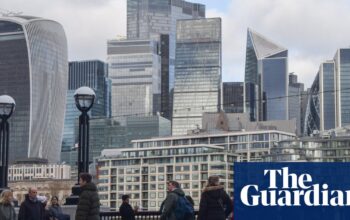They are not yet a century old but a collection of black and white photographs taken by a pioneering aerial photographer shows how very different aspects of everyday life are for Britons today.
The images, taken by Arthur William Hobart in the 1930s as he leant out of a biplane, capture people moving about on horse-drawn vehicles as well as in motorised ones, and rivers teeming with working boats.
There are striking images of industrial sites hemmed in by the terraces that housed their employees, and scenes of the British seaside that look a lot more genteel and less crowded than some of today’s brash resorts.
Historic England is releasing pictures from Hobart’s Air Pictures Portleven collection after organising and digitising them.
The collection features 242 images showing national landmarks, towns and cities, industrial sites, construction projects, cliffs and beaches, documenting the era between the two world wars.
Born in 1882 in London, Hobart worked as a baker, commercial traveller and draper’s clerk before turning to aerial photography around 1920.
He was commissioned by the construction industry, industrial sectors and the press, but also took pictures to be sold as postcards to people who were intrigued by a view of their country from a new perspective.

There are images in the collection of beloved buildings such as St Paul’s and Salisbury cathedrals, and pictures of the building of vital pieces of infrastructure such as Battersea power station and Twickenham Bridge in London. Most of the images show England but there are a few taken in Scotland and Wales.
Gary Winter, the engagement and content officer in the participation and learning team at Historic England, said he particularly liked the images that gave a glimpse of life for ordinary Britons, such as those showing the Potteries in Staffordshire with their extraordinary bottle-shaped kilns surrounded by the terrace homes of workers.
He said: “There are some fantastic views showing just how much some of the pottery sites were embedded within the cityscape itself. It shows how much these places of industry were embedded within the communities that actually worked them. There’s a huge contrast to the sort of deindustrialised landscape that we have around us now.”
Winter also likes the images of football grounds. “There’s a really good one of the Dell [Southampton FC’s former home ground]. Streets, houses and a church surround the stadium. The football ground is part of the community.”
The collection takes its name from a misspelling of Porthleven, a Cornish fishing village where Hobart lived in later life.
Duncan Wilson, the chief executive of Historic England, said: “Flicking through these photos lets you take flight over 1930s England, to see the changing face of the country in the interwar period.”
Source: theguardian.com


